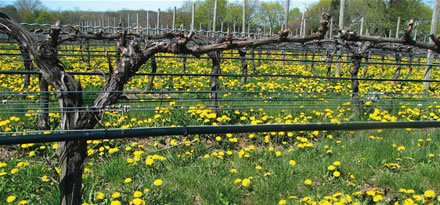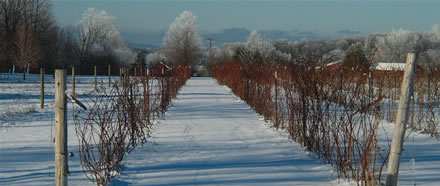
|
|
PRINT » |
|
|
E-MAIL THIS PAGE » |
|
|
CLOSE THIS WINDOW » |
Feature Article from the October 2007 Magazine Issue
Extreme Viticulture
How Northeast growers farm vinifera organically and sustainably

"Our goal was to make an extremely high quality of wine, and to integrate extreme viticulture in order to make it 100% organic," Shinn said. "The nay-sayers said we'd be lucky if 5% of the vineyard were organic."
Nine years later, 90% of the vineyards planted with Merlot, Cabernet Franc, Cabernet Sauvignon, Malbec, Petite Verdot, Sauvignon Blanc, Pinot Blanc and Sémillon are organic.
"It takes a really big paradigm change to do it, and a lot of people don't want to take the step forward," said Shinn, who gained considerable exposure to winemaking while working with vintners to develop custom wines for the list at Home Restaurant in Manhattan, which she owns with Page.
One of the more labor-intensive rituals she employs across her 19.5 acres are the compost tea drenches she runs through a drip irrigation system monthly during the growing season. Using a blend of ingredients including reconstituted seaweed and Mississippi catfish heads, tails and guts (Northeastern cod doesn't qualify because it inhabits saltwater and is heavily over-fished), Shinn consumes about 1.5 pounds of the mixture per acre under vine.
Fifty percent of the growth on the vineyard floor (above) is clover, which captures nitrogen and fixes it in the soil. When the clover is mowed, the decaying plant creates a "green," nitrogen-rich mulch. And since the soil is never disturbed, earthworms, bacteria and fungus remain intact, cultivating a healthy soil structure. Vines are trained in a vertical shoot position, and leaves are continually cleared away from grape clusters to allow light and air to penetrate.
"I want so badly for people to jump on board," said Shinn, who concedes that she grows frustrated with the slow pace of change around her. "There's no reason that someone else with a vineyard 10 feet away can't do the same thing."
When she decided to mount a "no-kill" vineyard operation, Shinn again encountered skeptics. By abstaining from the use of herbicides, observers cautioned her, she'd be fighting stiff competition in the root zone. But then Cornell University's viticulture extension program decided to study her vineyard two years in a row, and found no deficiencies in her vines.
"Our ability to harvest really high quality fruit year after year in the tremendously different weather from 2002 to 2006 shows that our techniques work," Shinn said.
Cornell's program
Organic orthodoxy aside, Shinn is one of 49 growers now participating in the sustainable viticulture program being offered by Cornell University, based on a workbook developed by Tim Martinson, Alice Wise, Jamie Hawk, Tim Weigle and Libby Tarleton. Last summer, there were 15.
Jamie Hawk, a sustainable viticulture educator based in Cornell's Penn Yan office in the Finger Lakes region, says the program now includes 18 growers in the Finger Lakes, one in the Hudson Valley, eight on Long Island, and 22 in the Lake Erie area.
Having completed self-assessments based on questions such as "Is crop thinning done in a thorough and conscientious manner?" and "Is fungal resistance considered when selecting varieties for planting?" for which answers are assigned point values from one to four (with four denoting a situation where substantial improvement is needed), the growers are now in various stages of action plan development.
"The hang-up in getting a lot of growers involved is that they see (the sustainable program) as another layer of regulations," said Hawk, a co-author of The New York Sustainable Viticulture Workbook who divides his time between field visits to participating growers and research in pursuit of new grants. "When they realize that they're already doing a large majority of what we're promoting, they get excited and motivated."
Tim Martinson, statewide senior extension associate for Cornell University's viticulture extension program and co-author of the workbook, said the diversity of grape farming in New York state, where grape juice growers exist alongside winegrape growers, has led to substantial changes in the way the manual approaches nitrogen fertilizers.
"With grape juice growers, the objective is maximum tonnage at minimum cost," Martinson said. "For vinifera and premium grapegrowers, this just doesn't apply."

At Long Island's Shinn Estate, the vineyard soil is never disturbed, which creates a healthy soil structure.
Raising Riesling
Up in Pulteney, N.Y., John Althouse is just getting st
arted. Three years ago, the former chemical engineer purchased land on the west side of Keuka Lake, and quickly realized its potential for the profitable cold climate Riesling, dubbing it Gilded Grapes, LLC.
He struck up a collaborative partnership with his neighbor Nancy Cole, who operates NVNOT Acres, and last November, put in 3,500 feet of drainage at a ratio of 700 feet per acre and tore out the Concord crop that occupied the land for 75 years. He added 8 tons of lime per acre to restore the proper pH, and is now submitting to regular soil sampling and analysis, both biological and chemical, by Cornell's grape program.
Although the Cornell cooperative extension service advised him to plant French hybrids, an impassioned plea by Fred Frank of the renowned Dr. Konstantin Frank Vinifera Wine Cellars 3 miles south in Hammondsport, N.Y.--in which Frank got down on his knees to dig into the soil--ultimately convinced the fledgling grower to plant Riesling.
"There's a natural swale in the terrain that would put French hybrids at risk," Althouse said. "Our air and soil temperatures are almost identical to those at Dr. Frank, and he faces an extremely short supply of premium Riesling."
So he has begun planting Arctic Riesling and Riesling 90 on 3309 rootstock, and Riesling 356 on 188-15 stock, he said, "to gain more insight into what grows best." He's also experimenting with securing the vines--tying one-third to tomato stakes, using grow tubes on another third, and tying one-third to the bottom wire.
Althouse planted his rows 8 feet apart and the vines 5 or 6 feet apart, depending on soil richness. Loath to implement a bare earth policy, he will plant grasses between the rows for erosion control, water retention and beautification. He said the space between the vine rows is enough to accommodate mechanical weed control equipment.
Althouse said he's been impressed by the collaborative attitude of most growers in the Finger Lakes community.
"My 35 years with Eastman Kodak, where you just didn't share anything about what you were learning, were absolutely the antithesis of what you see here," he said. "The growers are all too willing to observe, answer questions and be generous with their time, knowledge and equipment."
Having begun with 1.5 acres this year, he'll plant 5 more acres next year, and expects to have some harvestable fruit in 2010, followed by a fuller crop in 2011. He believes he will have invested approximately $8,000 per acre--not including the price of the land or the purchase of significant equipment.
Because the lake rarely freezes over, and because the vines sit just above a protective bluff, Althouse does not anticipate burying canes in winter, though he said he will be hilling up.

Farther north, on the shores of Lake Champlain and just a few miles across the border in Vermont, mounds and more mounds protect the vineyards of Kenneth Albert in winters known for their severity (above). Over the 25 years that the former IBM engineer traveled back and forth between his home in Vermont and business associates in Quebec to collaborate on the design of computer chips, he counted 20 commercial vineyards north of the border. He thought to himself, "If they can do it in Quebec, we can do it here."
In 1998, he decided to expand his 2-decades-old backyard grapegrowing hobby into a full-time pursuit by planting Shelburne Vineyard, one of only a handful of sustainable vineyards in the state, and the only one certified organic. It wasn't easy.
"When I started, I had no support at all," said Albert, who runs the three-parcel operation consisting of the Breeding Barn, Route 7 and Meach Cove growing sites, with his wife Gayle. "I did it all on my own, and got certified by NOFA on half the vineyards." (NOFA is the acronym for Northeast Organic Farming Association.)

Late this August, some Riesling vines at Shelburne Vineyards showed black rot and leafhopper damage
"If you're not planting vinifera in the East, you can manage organically," Albert said. "But if you're planting vinifera, it's a very tough road. There's no organically approved ingredient to fight black rot. A constant wind is the best pesticide you can find, because it minimizes the incubation of bacteria."
With a total of 9 acres now in production, he will soon double his output from 1,000 cases to 2,000 cases, which he sells to restaurants and retailers across the state, as well as through the winery's new tasting room. The vineyards are planted with a combination of vinifera and hybrids, including Riesling, Zweigelt, Cayuga White, Vidal, Vignoles, Traminette, La Crescent and St. Croix, among others.
Kevin Zraly is the first to say that sustainable and organic viticulture are not for those who faint in the face of adversity. A self-described four-time viticultural failure, the wine author and educator is determined to cultivate vinifera organically. He has chosen the notoriously inhospitable climate of New York's Hudson Valley as his laboratory.
"That way I'll have an excuse," he said. In the belief that he shouldn't write a word about wine unless he's had the experience of laboring between the vineyard rows, Zraly has planted 200 vines each of Cabernet Franc, Pinot Noir, Chardonnay, Riesling and Pinot Gris.
But when July and August roll around, Japanese beetles are the bane of his existence. Two or three times a day, he shakes the vines and hopes the bugs drown in a bucket of water he totes along.
"We've got everything else going for us," he said. "Good enough soil, drainage and sunlight."
Based in New York, Suzanne Gannon writes on travel, culture, food and wine. For the past two years, she has reported on a variety of topics for Wines & Vines. Reach her through edit@winesandvines.com.
|
|
PRINT » |
|
|
E-MAIL THIS ARTICLE » |
|
|
CLOSE THIS WINDOW » |
